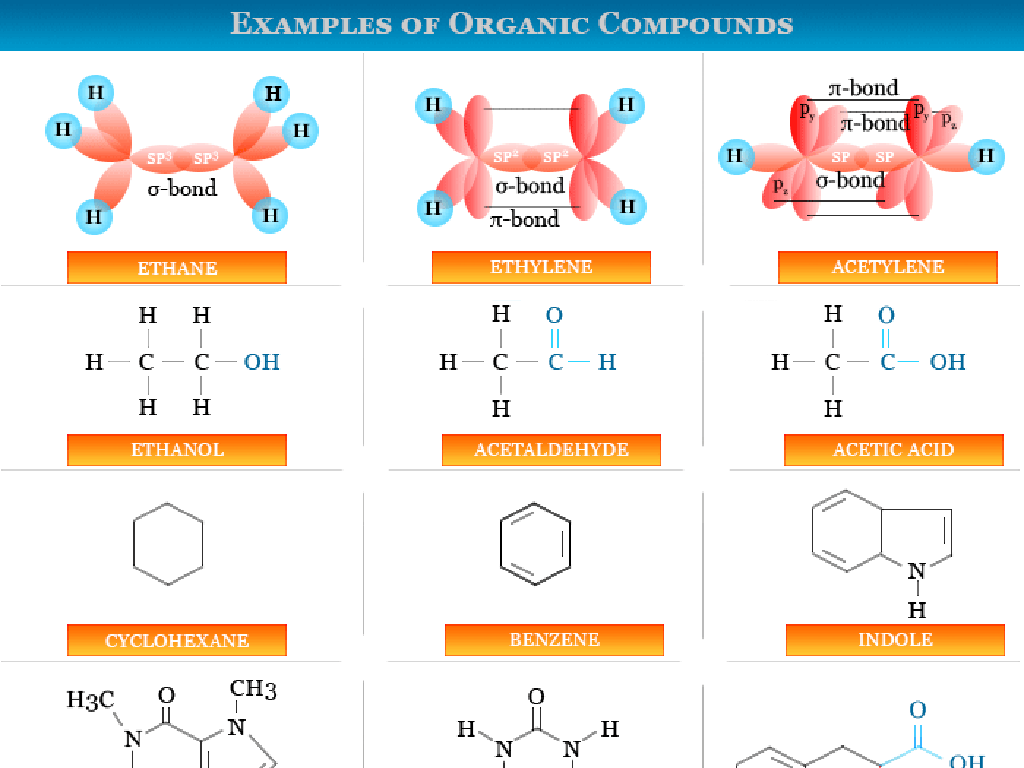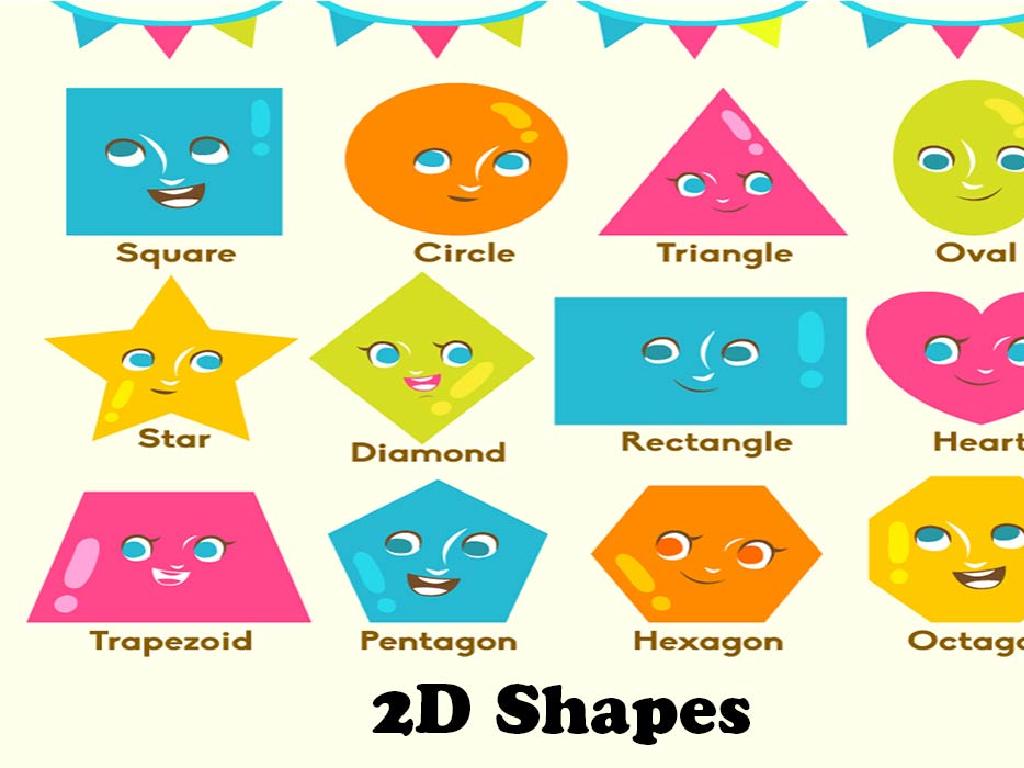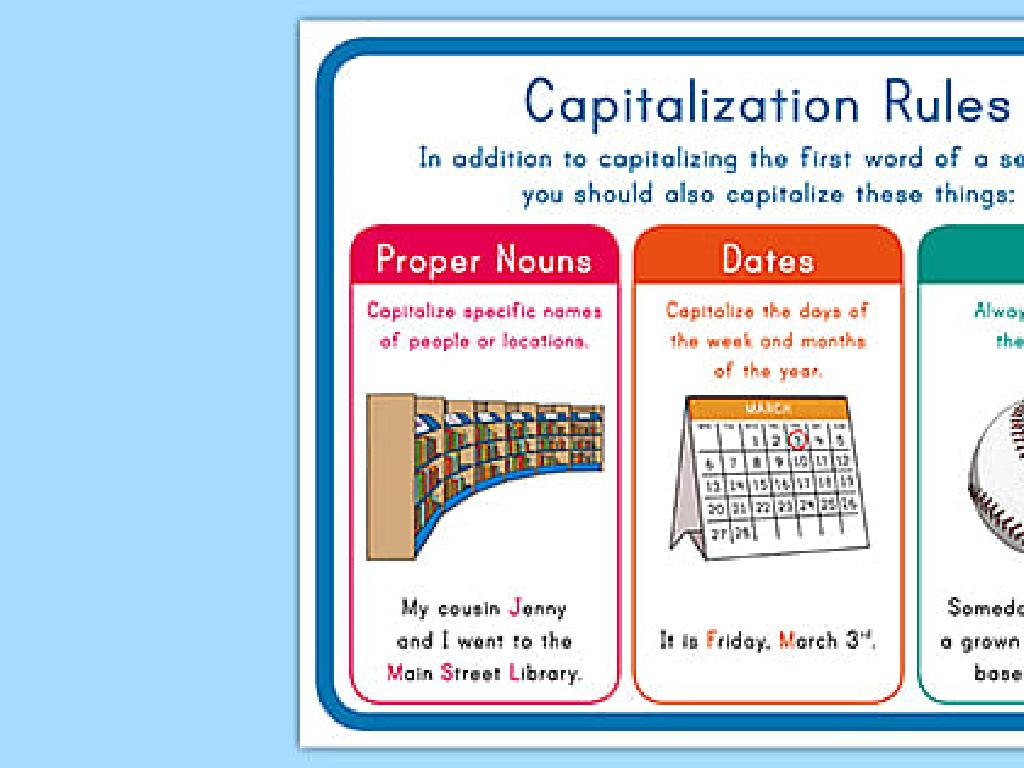Prepositions: Review
Subject: Language arts
Grade: Fourth grade
Topic: Prepositions
Please LOG IN to download the presentation. Access is available to registered users only.
View More Content
Welcome to Prepositions!
– Prepositions define relationships
– They tell us where or when something is
– Connect nouns/pronouns to sentence elements
– Like glue, they link nouns to other words
– Examples: on, in, under, over, between
– ‘On the table’, ‘under the bed’, ‘between the pages’
– Usage in everyday language
|
This slide introduces the concept of prepositions to fourth-grade students, explaining that prepositions are words that show the relationship between nouns or pronouns and other parts of a sentence. They function like ‘glue’, connecting ideas and indicating relationships such as location or time. Provide clear examples for each preposition mentioned, and encourage students to think of additional examples from their daily lives. Emphasize the importance of prepositions in constructing sentences that make sense. As an activity, students could be asked to create sentences using the prepositions provided or to find prepositions in a reading passage.
Where is the Cat? Understanding Prepositions
– Prepositions show location
– ‘On’, ‘in’, and ‘under’ explained
– ‘On’ means the cat is atop, ‘in’ means inside, ‘under’ means beneath the box
– Activity: Locate the cat using prepositions
– Describe the cat’s location in relation to the box
– Practice using prepositions in sentences
– Use prepositions to tell where things are in the classroom
|
This slide introduces students to the concept of prepositions as words that show the location of one thing in relation to another. Use a simple and engaging activity where students describe the position of a cat in relation to a box using prepositions like ‘on’, ‘in’, and ‘under’. This will help them understand how prepositions function in a sentence. After explaining the activity, allow students to practice by forming sentences that describe where various objects are located in the classroom. Encourage them to think creatively and share their sentences with the class to reinforce their understanding of prepositions.
Exploring Prepositions in Sentences
– Identify prepositions in sentences
– Understand prepositions’ role
– Prepositions show the relationship between nouns or pronouns and other words in a sentence.
– ‘The book is on the table’
– ‘on’ shows the book is resting atop the table surface.
– ‘The book is under the table’
– ‘under’ indicates the book is below the table surface.
|
This slide aims to review the concept of prepositions for fourth graders. Start by explaining that prepositions are words that show the relationship between a noun or pronoun and other parts of the sentence. They can indicate time, place, direction, and more. Use the examples provided to illustrate how changing the preposition alters the sentence’s meaning, affecting the position of the book relative to the table. Encourage students to come up with additional examples and to practice identifying prepositions in sentences from their reading or in the classroom.
Time and Place Prepositions
– Prepositions show when or where
– Examples: at, in, on
– ‘at 3 o’clock’, ‘in the morning’, ‘on Monday’, ‘at the park’
– Activity: Matching prepositions
– Match prepositions to time or place
– Enhance understanding of usage
|
This slide is aimed at reviewing the concept of prepositions related to time and place. Prepositions are words that link nouns, pronouns, or phrases to other words within a sentence and can indicate temporal or spatial relationships. For example, ‘at’ is often used with specific times, ‘in’ with months, seasons, or parts of the day, and ‘on’ with days and dates. The activity involves matching prepositions to their correct time or place, reinforcing the rules of usage. For instance, students will decide whether to use ‘at’, ‘in’, or ‘on’ for given times and places. This interactive exercise will help solidify their understanding of prepositions. Teachers should prepare a list of sentences with missing prepositions for the activity and discuss the correct answers afterward.
Prepositions of Movement
– Prepositions show direction
– Examples: towards, into, out of
– ‘The cat ran towards the house’, ‘She walked into the room’
– Create sentences with movement prepositions
– Use the examples to make your own sentences
– Share your sentences in class
|
This slide introduces prepositions that indicate movement or direction. Start by explaining that prepositions can tell us where or when something is in relation to something else. Provide clear examples using ‘towards’, ‘into’, ‘out of’, ‘from’, and ‘to’. For the activity, instruct students to think of actions involving movement and to create sentences using the given prepositions. Encourage creativity and provide guidance on sentence structure. During the next class, have students share their sentences to reinforce their understanding and to practice speaking. Prepare to offer feedback and additional examples to clarify any misunderstandings.
Let’s Play: Preposition Treasure Hunt
– Engage in a Preposition Treasure Hunt
– Follow clues to find hidden treasure
– Each clue includes a guiding preposition
– Clues like ‘under the clock’ or ‘behind the door’
– Understand prepositions through play
– Learn how prepositions describe location
|
This interactive game is designed to help students review prepositions in a fun and engaging way. Set up a treasure hunt in the classroom where each clue leads to the next location, using prepositions to describe where the next clue can be found. For example, ‘Look under the table,’ ‘Go behind the bookshelf,’ or ‘Walk towards the window.’ This activity will reinforce the concept of prepositions as words that link nouns, pronouns, or phrases to other words within a sentence and express relationships of time, space, and direction. Prepare a variety of clues and ensure that each student has a chance to participate. The treasure at the end can be a small treat or a congratulatory note to celebrate their success in using prepositions to navigate the hunt.
Class Activity: Preposition Art
– Create your own Preposition Art
– Draw a scene with many objects
– Describe the scene using prepositions
– Use prepositions like ‘above’, ‘below’, ‘beside’, ‘between’ to tell where things are.
– Share your artwork in class
|
This activity is designed to help students understand and use prepositions in a fun and creative way. Students will draw a scene, such as a park, a room, or a street, and then write sentences describing the positions of various objects using prepositions. For example, ‘The cat is under the tree’ or ‘The airplane is above the clouds’. Encourage creativity in their drawings and ensure they use a variety of prepositions. After completing their artwork, students will share their drawings and sentences with the class, enhancing their speaking skills and reinforcing their understanding of prepositions. Possible variations of the activity could include pairing students to describe each other’s artwork, creating a gallery walk where students view and discuss artwork, or even integrating technology by having students create digital art.
Prepositions: Review and Practice
– Recap on prepositions
– Prepositions are words that show location or time, like ‘on’, ‘in’, ‘before’, and ‘after’.
– Practice with a worksheet
– Fill in the blanks in sentences with the right prepositions.
– Homework: A preposition story
– Write a story and use prepositions you’ve learned. Underline each one.
|
Begin with a brief review of prepositions, ensuring students recall that prepositions are words that link nouns, pronouns, or phrases to other words within a sentence and express relationships of time, place, direction, etc. Distribute a worksheet with sentences missing prepositions for students to fill in, reinforcing their understanding through practice. For homework, assign students to write a short story, incorporating as many prepositions as they can, and underline them. This will help them identify and use prepositions in their writing. In the next class, review some of the stories to highlight the use of prepositions in context.





